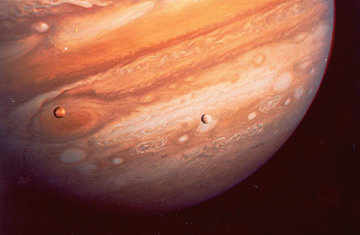
A portion of planet Jupiter and its moons Io, left, and Europa, as seen by Voyager 1 at a distance of 375,000 miles
Aug. 20, 1977 and September 5, 1977 — The solar system is something of a gnat swarm of bodies, with eight planets, dozens of moons and thousands of bits of rubble and ice all swirling at different speeds and in different orbits. The planets alone vary wildly, with Mercury making a complete sprint around the sun in just 88 days, Earth needing a year to jog through its route, and Neptune plodding along in a slow, 165-year circle. All this means that it's hard to get any two worlds to line up, never mind three or more. In 1966, however, a bright investigator at the Jet Propulsion Laboratory calculated that no fewer than four planets —Jupiter, Saturn, Uranus and Neptune — were drifting into a rare alignment that would make it possible for a single ship to fly by them all. The conga line would begin to form in 1979; miss it and you'd have to wait another 176 years. Voyagers 2 and 1 (launched out of order due to a technical glitch) were sent out to take advantage of the opportunity. Voyager 1 was deliberately targeted for a particularly close pass by Saturn's moon Titan, which would fling it up and out of the plane of the solar system before it could explore the last two of the gas giants, but Voyager 2 successfully flew by and photographed all four. Both ships remain in faint contact with Earth even today.